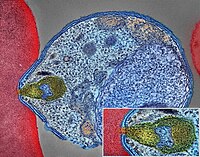
Photo from wikipedia
BackgroundChina has experienced a rapid increase in hypertension over the past decade, especially in rural. Therefore, the aim of this research is to examine the dynamic trends in urban-rural disparities… Click to show full abstract
BackgroundChina has experienced a rapid increase in hypertension over the past decade, especially in rural. Therefore, the aim of this research is to examine the dynamic trends in urban-rural disparities in hypertension prevalence, detection, and medication use among Chinese adults from 1993 to 2011.MethodsData were extracted from the seven latest waves of the China Health and Nutrition Survey (CHNS). We used the hukou system to distinguish between urban and rural residents. Chi-square tests were performed to examine urban-rural gaps in hypertension prevalence, detection and medication use. Multiple logistic regressions were used to confirm these disparities and to explore whether the urban-rural gaps have narrowed or widened from 1993 to 2011, after controlling for health-related behaviors, BMI, demographic variables and socioeconomic characteristics. Blinder-Oaxaca decomposition technique was also used to calculate the extent to which urban-rural disparities reflect an endowments effect or a coefficients effect.ResultsHypertension prevalence, detection, and medication use among rural adults were significantly lower than urban adults, with the significant level at p < 0.001. The urban-rural gaps in hypertension prevalence and medication use gradually narrowed during the period 1993–2011, whereas the gaps in hypertension detection grew wider. After controlling for confounding variables, urban adults were about 24.5, 49.4, and 89.5% more likely to be hypertensive, detected, and medicated than their rural counterparts (p < 0.01), respectively. The Blinder-Oaxaca decomposition suggested that approximately 22 and 26% of the urban-rural gap in hypertension detection and medication use could be attributed to coefficient difference, respectively.ConclusionsAlthough hypertension prevalence among rural adults was comparable to that of urban adults, hypertension detection and medication use of rural adults were still suboptimal. Unusually large urban-rural gaps and an expanding trend in hypertension detection deserve the attention of health policymakers and researchers.
Journal Title: International Journal for Equity in Health
Year Published: 2017
Link to full text (if available)
Share on Social Media: Sign Up to like & get
recommendations!